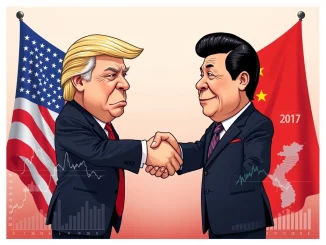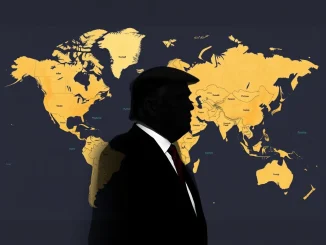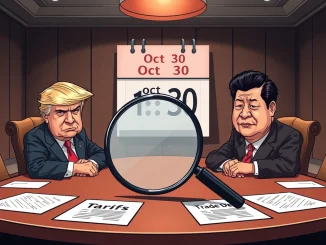
In a surprising turn of events that has the global market holding its breath, the European Union has decided to press pause on implementing countermeasures against the United States. This news, arriving hot off the heels of concerns about escalating trade tensions, offers a temporary reprieve, but is it a genuine breakthrough or just a momentary pause in a looming trade war?
What’s Behind the EU’s Decision to Pause US Tariffs?
European Commission President Ursula von der Leyen dropped the news like a diplomatic bombshell, announcing a 90-day suspension of planned countermeasures. These countermeasures, initially slated for enforcement on April 15th, were in response to ongoing trade disputes between the EU and the US. According to a post by Walter Bloomberg on X, the suspension is conditional. Von der Leyen has explicitly stated that these countermeasures are merely paused, not cancelled, and will be firmly enforced if negotiations with the U.S. fail to yield a satisfactory resolution within this 90-day window. This development confirms earlier reports from Coin Pulse, which hinted at the EU considering this 90-day postponement.
Why Were EU Tariffs on the Horizon?
To understand the significance of this pause, we need to rewind a bit. The threat of EU tariffs stems from long-standing trade disagreements between the European Union and the United States. These disputes cover a range of issues, from aircraft subsidies to digital services taxes. The EU’s planned countermeasures were a direct response to what they perceived as unfair trade practices by the US, aiming to level the playing field and protect European industries.
Think of it like this:
- Tit-for-Tat Trade Tactics: In international trade, tariffs are often used as leverage. If one country imposes tariffs on another’s goods, the affected country might retaliate with its own tariffs. This is essentially what the EU was preparing to do.
- Protecting European Interests: The EU’s move to impose tariffs was aimed at sending a strong message to the US and safeguarding European businesses from what they considered detrimental US tariffs and trade policies.
- Negotiating Power: By threatening tariffs, the EU hoped to bring the US back to the negotiating table and find mutually agreeable solutions to their trade disputes.
What About US Tariffs? The Root of the Dispute
The US, under previous administrations, has also been assertive in its trade policies, imposing tariffs on goods from various countries, including the EU. These US tariffs were often justified as measures to protect American industries, reduce trade deficits, and ensure fair trade practices. However, these actions have been met with criticism and retaliatory measures from trading partners, including the EU.
Key areas of contention leading to potential US tariffs and EU retaliation include:
| Dispute Area | Description |
|---|---|
| Aircraft Subsidies | Long-running dispute over government subsidies provided to aircraft manufacturers like Boeing (US) and Airbus (EU). |
| Digital Services Tax | Some EU member states have implemented digital services taxes targeting large US tech companies, which the US views as discriminatory. |
| Steel and Aluminum Tariffs | The US imposed tariffs on steel and aluminum imports, citing national security concerns, which affected EU exporters. |
Is a Trade War Still a Threat?
The million-dollar question is: does this 90-day pause mean the threat of a full-blown trade war is over? Not necessarily. While the suspension is undoubtedly a positive step, it’s crucial to understand that it’s temporary. Von der Leyen’s warning is clear: if negotiations fail to produce a breakthrough, the EU is ready to proceed with its countermeasures. This means the next 90 days are critical for diplomatic efforts to bridge the gap between the EU and the US.
The implications of a trade war are far-reaching and could include:
- Increased Costs for Businesses and Consumers: Tariffs raise the price of imported goods, which can be passed on to consumers in the form of higher prices. Businesses that rely on imported materials also face increased costs.
- Disruptions to Supply Chains: Trade wars can disrupt established supply chains, forcing companies to find new sources of materials and components, potentially leading to delays and inefficiencies.
- Economic Slowdown: Escalating trade tensions and tariffs can negatively impact economic growth, both domestically and globally, by reducing trade volumes and investment.
- Market Volatility: Uncertainty surrounding trade policy can lead to increased volatility in financial markets, including cryptocurrency markets, as investors react to shifting economic landscapes.
The Ripple Effect on Global Trade
This EU-US trade situation is not just a bilateral issue; it has implications for global trade as a whole. The EU and the US are two of the world’s largest economies, and their trade relationship is a cornerstone of the global trading system. Escalating tensions between them could undermine the rules-based international order and encourage protectionist policies worldwide.
A healthy global trade environment is essential for:
- Economic Growth and Development: Trade fosters competition, innovation, and efficiency, driving economic growth and development in participating countries.
- Geopolitical Stability: Economic interdependence through trade can promote cooperation and reduce the likelihood of conflict between nations.
- Access to Goods and Services: Global trade allows consumers to access a wider variety of goods and services at competitive prices.
What’s the Potential Economic Impact?
The economic impact of this 90-day pause, and the potential outcomes of the negotiations, are significant. A successful resolution would be a major positive for the global economy, easing uncertainty and fostering a more stable trade environment. However, if negotiations fail and tariffs are implemented, the economic impact could be negative, leading to slower growth and increased market volatility.
Let’s consider the potential economic impact scenarios:
| Scenario | Likely Economic Impact |
|---|---|
| Successful Negotiation & Tariff Removal | Positive: Reduced uncertainty, improved business confidence, potential for increased trade and economic growth. |
| Negotiation Failure & Tariff Implementation | Negative: Increased costs for businesses and consumers, supply chain disruptions, potential for slower economic growth and market volatility. |
| Prolonged Uncertainty & Repeated Pauses | Mixed: Short-term relief from each pause, but continued uncertainty can dampen investment and long-term economic planning. |
Looking Ahead: What Happens Next?
The next 90 days are crucial. All eyes will be on the EU-US negotiations to see if a lasting solution can be found. Businesses, investors, and consumers alike are hoping for a positive outcome that avoids a damaging trade war. For the cryptocurrency market, which is often sensitive to global economic shifts, a resolution would likely be welcomed, reducing uncertainty and potentially fostering a more stable investment climate. However, the threat of renewed tensions remains, and vigilance is key. Stay tuned for updates as this developing situation unfolds.



